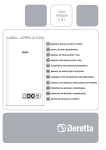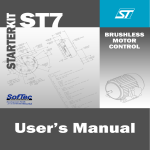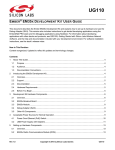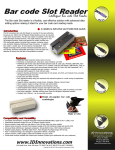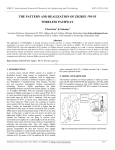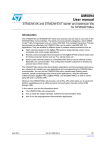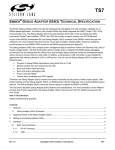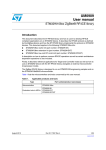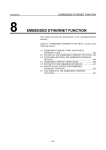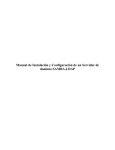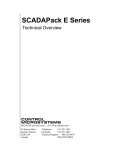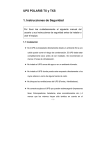Download EmberZNet utilities
Transcript
UM0924
User manual
EmberZNet™ utilities
1
Introduction
Purpose
This document describes how and when to use the standalone EmberZNet™ utilities
supplied with EmberZNet™ software.
It is recommended that you review this document to familiarize yourself with each utility and
its intended use. You can refer to specific sections of this document to access operational
information as needed.
Audience
This document is intended for software and hardware engineers who are responsible for
building an embedded mesh networking solution using the STM32W108 system-on-chip.
This document assumes that the reader has a solid understanding of embedded systems
design.
Document organization
STM32W108 kit customers are eligible for training and technical support. You can use the
STMicroelectronics web site, www.st.com/mcu, STM32W section to obtain information
about all STM32W108 products and services, and to sign up for product support.
March 2010
Doc ID 17267 Rev 1
1/20
www.st.com
Contents
UM0924
Contents
1
Introduction . . . . . . . . . . . . . . . . . . . . . . . . . . . . . . . . . . . . . . . . . . . . . . . . 1
2
Introduction to EmberZNet utilities . . . . . . . . . . . . . . . . . . . . . . . . . . . . . 4
3
2.1
Tool overview . . . . . . . . . . . . . . . . . . . . . . . . . . . . . . . . . . . . . . . . . . . . . . . 4
2.2
File format overview . . . . . . . . . . . . . . . . . . . . . . . . . . . . . . . . . . . . . . . . . . 4
2.2.1
S-record file format . . . . . . . . . . . . . . . . . . . . . . . . . . . . . . . . . . . . . . . . . 4
2.2.2
Ebl bootloader file format . . . . . . . . . . . . . . . . . . . . . . . . . . . . . . . . . . . . . 4
EM3XX_LOAD . . . . . . . . . . . . . . . . . . . . . . . . . . . . . . . . . . . . . . . . . . . . . . 6
3.1
Introduction . . . . . . . . . . . . . . . . . . . . . . . . . . . . . . . . . . . . . . . . . . . . . . . . 6
3.2
Purpose . . . . . . . . . . . . . . . . . . . . . . . . . . . . . . . . . . . . . . . . . . . . . . . . . . . 6
3.2.1
4
2/20
Usage . . . . . . . . . . . . . . . . . . . . . . . . . . . . . . . . . . . . . . . . . . . . . . . . . . . 6
3.3
Example (load) . . . . . . . . . . . . . . . . . . . . . . . . . . . . . . . . . . . . . . . . . . . . . . 6
3.4
Example (bootload image) . . . . . . . . . . . . . . . . . . . . . . . . . . . . . . . . . . . . . 7
3.5
Example (enable write protect) . . . . . . . . . . . . . . . . . . . . . . . . . . . . . . . . . . 7
3.6
Example (disable write protect) . . . . . . . . . . . . . . . . . . . . . . . . . . . . . . . . . 8
3.7
Example (erase and unprogram write protect) . . . . . . . . . . . . . . . . . . . . . . 8
3.8
Example (print flash contents) . . . . . . . . . . . . . . . . . . . . . . . . . . . . . . . . . . 9
3.9
Example (read flash contents to file) . . . . . . . . . . . . . . . . . . . . . . . . . . . . 10
3.10
Example (patch flash) . . . . . . . . . . . . . . . . . . . . . . . . . . . . . . . . . . . . . . . . 10
3.11
Example (patch using input file) . . . . . . . . . . . . . . . . . . . . . . . . . . . . . . . . 11
3.12
Example (patch to a target file) . . . . . . . . . . . . . . . . . . . . . . . . . . . . . . . . 11
3.13
Example (print CIB tokens) . . . . . . . . . . . . . . . . . . . . . . . . . . . . . . . . . . . 12
3.14
Example (dump CIB tokens) . . . . . . . . . . . . . . . . . . . . . . . . . . . . . . . . . . 13
3.15
Example (patch CIB tokens) . . . . . . . . . . . . . . . . . . . . . . . . . . . . . . . . . . . 14
3.16
Scripting . . . . . . . . . . . . . . . . . . . . . . . . . . . . . . . . . . . . . . . . . . . . . . . . . . 15
EM3XX_CONVERT . . . . . . . . . . . . . . . . . . . . . . . . . . . . . . . . . . . . . . . . . . 16
4.1
Introduction . . . . . . . . . . . . . . . . . . . . . . . . . . . . . . . . . . . . . . . . . . . . . . . 16
4.2
Purpose . . . . . . . . . . . . . . . . . . . . . . . . . . . . . . . . . . . . . . . . . . . . . . . . . . 16
4.3
Usage . . . . . . . . . . . . . . . . . . . . . . . . . . . . . . . . . . . . . . . . . . . . . . . . . . . . 16
4.4
Example (convert .s37 to .ebl) . . . . . . . . . . . . . . . . . . . . . . . . . . . . . . . . . 16
Doc ID 17267 Rev 1
UM0924
5
6
Contents
4.5
Example (using --imageinfo and -- timestamp) . . . . . . . . . . . . . . . . . . . . 16
4.6
Scripting . . . . . . . . . . . . . . . . . . . . . . . . . . . . . . . . . . . . . . . . . . . . . . . . . . 17
Error messages . . . . . . . . . . . . . . . . . . . . . . . . . . . . . . . . . . . . . . . . . . . . 18
5.1
Introduction . . . . . . . . . . . . . . . . . . . . . . . . . . . . . . . . . . . . . . . . . . . . . . . 18
5.2
Example . . . . . . . . . . . . . . . . . . . . . . . . . . . . . . . . . . . . . . . . . . . . . . . . . . 18
Revision history . . . . . . . . . . . . . . . . . . . . . . . . . . . . . . . . . . . . . . . . . . . 19
Doc ID 17267 Rev 1
3/20
Introduction to EmberZNet utilities
2
UM0924
Introduction to EmberZNet utilities
Designers using EmberZNet's ZigBee Network Stack software (EmberZNet) and
development tools must use one of the standalone utilities installed with the rest of the
software. These utilities are software tools that perform tasks not integrated into the normal
Integrated Development Environment (IDE).
These tools may vary with the specific version of the installed STMicrolectronics product. If
you do not have one of these utilities, contact support at www.st.com/mcu, STM32W section
to learn how to get a copy.
The utilities included in this document are listed in the table below.
Table 1.
Utilities covered in this document
Utility
2.1
Description
Section
em3xx_load
Programming utilities for STM32W108 system-on-chip.
Section 3
em3xx_convert
Converts files from one format to another.
Section 4
Tool overview
EmberZNet's networking device family requires various kinds of device programming. Gang
programmers are frequently used in a manufacturing environment, while single device
programmers are used most often in a development or pilot production environment.
2.2
File format overview
The STM32W108 family of tools works with different file formats: .bin, .s37 and .ebl (used for
bootloaders). Each file format serves a slightly different purpose. The EmberZNet stack
contains a conversion tool, em3xx_convert, which converts applications from one file format
to another (.s37 to .ebl). The s37 and ebl file formats are summarized below.
2.2.1
S-record file format
EmberZNet sample applications use the IAR Embedded Workbench as its IDE. The IDE
produces Motorola S-record files, s37 specifically, as its output. An application image in s37
format can be loaded into a target STM32W108 using the em3xx_load utility. The s37 format
can represent any combination of any byte of Flash memory in the STM32W108. The
em3xx_convert utility can be used to convert the s37 format to ebl format for use with
EmberZNet bootloaders.
2.2.2
Ebl bootloader file format
The ebl bootloader file format is generated by the em3xx_convert utility. This file format can
only represent an application image.
The ebl file format is designed to be an efficient and fault-tolerant image format for use with
EmberZNet's bootloader to upgrade an application without the need for special
programming devices. The bootloader can receive an ebl file either Over The Air (OTA) or
via a serial cable and reprogram the Flash memory in place.
4/20
Doc ID 17267 Rev 1
UM0924
Introduction to EmberZNet utilities
Although the ebl file format is intended for use with a bootloader, the em3xx_load utility is
also capable of directly programming an ebl image. This file format is generally used in later
stage development, and for upgrading manufactured devices in the field. The standalone
bootloader should never be loaded onto the device as an ebl image. Use the s37 file format
when loading the bootloader itself.
Table 2summarizes the inputs and outputs for the different file formats.
Table 2.
File format summary
Inputs
em3xx_load
em3xx_convert
ebl
s37
X
X
Outputs
chip
X
Doc ID 17267 Rev 1
ebl
s37
chip
X
X
5/20
EM3XX_LOAD
3
EM3XX_LOAD
3.1
Introduction
UM0924
The em3xx_load utility is used in any loading operation. It is delivered within the stack
(tools/em3xx folder).
3.2
Purpose
The em3xx_load utility is a command line (DOS console) application that can be used to
program the Flash memory space of the STM32W108 via the Serial Wire/JTAG interface.
3.2.1
Usage
To use the em3xx_load utility, you should be working from the command line.
Note:
You can use the --help command at any time to print out full usage information. The
examples listed in this document do not describe every feature of em3xx_load. Refer to the
--help command for full documentation of em3xx_load.
Note:
All em3xx_load commands, modifiers, and options are case sensitive.
The path to the utility executable and the image files (<pathToUtility>/em3xx_load.exe
<pathToImage>/sink.s37) must be specified when invoking em3xx_load but is left out of the
examples for brevity.
3.3
Example (load)
Command line input
$ em3xx_load.exe sensor.s37
Uploads the image in sensor.s37 to the STM32W108. The Flash memory pages
encompassing the bytes defined in the .s37 file will be erased first. Once the chip is
programmed, the application will be run.
This example transaction would look like the following when executed.
Command line output
em3xx_load (Version 1.0b27.1264522950)
Connecting to ISA via USB Device 0
DLL version 1.1.9, compiled Jan 29 2010 18:36:00
SerialWire interface selected
SWJCLK speed is 500kHz
Targeting STM32W108
Parse .s37 format for flash
Reset Chip
Install RAM image
Verify RAM image
Install Flash image
6/20
Doc ID 17267 Rev 1
UM0924
EM3XX_LOAD
Verify Flash image
Mark application image valid
Verifying bootloader and application
Run (by toggling nRESET)
DONE
3.4
Example (bootload image)
Command line input
$ em3xx_load.exe serial-uart-bootloader.s37 sensor.s37
This command loads the bootloader and application images simultaneously.
This example transaction would look like the following when executed.
Command line output
em3xx_load (Version 1.0b27.1264522950)
Connecting to ISA via USB Device 0
DLL version 1.1.9, compiled Jan 29 2010 18:36:00
SerialWire interface selected
SWJCLK speed is 500kHz
Targeting STM32W108
Parse .s37 format for flash
Parse .s37 format for flash
Reset Chip
WARNING: Replacing bootloader
Install RAM image
Verify RAM image
Install Flash image
Verify Flash image
Mark application image valid
Verifying bootloader and application
Run (by toggling nRESET)
DONE
3.5
Example (enable write protect)
Command line input
$ em3xx_load.exe --programwrprot 000000
This command programs write protection enabled for all Flash memory pages.
This example transaction would look like the following when executed.
Command line output
em3xx_load (Version 1.0b27.1264522950)
Connecting to ISA via USB Device 0
DLL version 1.1.9, compiled Jan 29 2010 18:36:00
SerialWire interface selected
Doc ID 17267 Rev 1
7/20
EM3XX_LOAD
UM0924
SWJCLK speed is 500kHz
Targeting STM32W108
Reset Chip
Setting Option Byte 4 to 0x00
Setting Option Byte 5 to 0x00
Setting Option Byte 6 to 0x00
Create image file
Install RAM image
Verify RAM image
Install Flash image
Verify Flash image
Run (by toggling nRESET)
DONE
3.6
Example (disable write protect)
Command line input
$ em3xx_load.exe --programwrprot FFFFFF
This command programs write protection disabled for all Flash memory pages.
This example transaction would look like the following when executed.
Command line output
em3xx_load (Version 1.0b27.1264522950)
Connecting to ISA via USB Device 0
DLL version 1.1.9, compiled Jan 29 2010 18:36:00
SerialWire interface selected
SWJCLK speed is 500kHz
Targeting STM32W108
Reset Chip
Setting Option Byte 4 to 0xFF
Setting Option Byte 5 to 0xFF
Setting Option Byte 6 to 0xFF
Create image file
Install RAM image
Verify RAM image
Install Flash image
Verify Flash image
Run (by toggling nRESET)
DONE
3.7
Example (erase and unprogram write protect)
Command line input
$ em3xx_load.exe --erasewrprot
8/20
Doc ID 17267 Rev 1
UM0924
EM3XX_LOAD
This command erases the write protection option bytes for all Flash memory pages, leaving
those option bytes in an unprogrammed state. An unprogrammed state is equivalent to
disabled write protection.
This example transaction would look like the following when executed.
Command line output
em3xx_load (Version 1.0b27.1264522950)
Connecting to ISA via USB Device 0
DLL version 1.1.9, compiled Jan 29 2010 18:36:00
SerialWire interface selected
SWJCLK speed is 500kHz
Targeting STM32W108
Reset Chip
Erasing Option Byte 4
Erasing Option Byte 5
Erasing Option Byte 6
Create image file
Install RAM image
Verify RAM image
Install Flash image
Verify Flash image
Run (by toggling nRESET)
DONE
3.8
Example (print flash contents)
Command line input
$ em3xx_load.exe --read @08040800-0804080F
This command prints all 16 bytes that comprise the 8 option bytes to the screen.
This example transaction would look like the following when executed.
Command line output
em3xx_load (Version 1.0b27.1264522950)
Connecting to ISA via USB Device 0
DLL version 1.1.9, compiled Jan 29 2010 18:36:00
SerialWire interface selected
SWJCLK speed is 500kHz
Targeting STM32W108
Reset Chip
Getting memory from 0x08040800 through 0x0804080F
{address: 0 1 2 3 4 5 6 7 8 9 A B C D E F}
08040800: A5 5A FF 00 FF 00 FF 00 FF FF FF FF FF FF FF 00
Run (by toggling nRESET)
DONE
Doc ID 17267 Rev 1
9/20
EM3XX_LOAD
3.9
UM0924
Example (read flash contents to file)
Command line input
$ em3xx_load.exe --read @mfb @fib @cib myreadfile.s37
This command uses the address aliases (mfb, fib, and cib) to read the entire Flash memory
contents of the chip into the output file, myreadfile.s37.
This example transaction would look like the following when executed.
Command line output
em3xx_load (Version 1.0b27.1264522950)
Connecting to ISA via USB Device 0
DLL version 1.1.9, compiled Jan 29 2010 18:36:00
SerialWire interface selected
SWJCLK speed is 500kHz
Targeting STM32W108
Reset Chip
Getting memory from 0x08000000 through 0x0802FFFF
Getting memory from 0x08040000 through 0x080407FF
Getting memory from 0x08040800 through 0x08040FFF
Create image file
Run (by toggling nRESET)
DONE
3.10
Example (patch flash)
Command line input
$ em3xx_load.exe --patch @08040FFE=12 @08040FFF=34
This command patches the very last two bytes of the CIB to be 0x12 and 0x34.
This example transaction would look like the following when executed.
Command line output
em3xx_load (Version 1.0b27.1264522950)
Connecting to ISA via USB Device 0
DLL version 1.1.9, compiled Jan 29 2010 18:36:00
SerialWire interface selected
SWJCLK speed is 500kHz
Targeting STM32W108
Reset Chip
Setting memory at 0x08040FFE to 0x12
Setting memory at 0x08040FFF to 0x34
Create image file
Install RAM image
Verify RAM image
Install Flash image
Verify Flash image
10/20
Doc ID 17267 Rev 1
UM0924
EM3XX_LOAD
Run (by toggling nRESET)
DONE
3.11
Example (patch using input file)
Command line input
$ em3xx_load.exe --patch sensor.ebl @08040FFE=12 @08040FFF=34
This command uses patch to simultaneously program an image and program the very last
two bytes of the CIB to be 0x12 and 0x34.
This example transaction would look like the following when executed.
Command line output
em3xx_load (Version 1.0b27.1264522950)
Connecting to ISA via USB Device 0
DLL version 1.1.9, compiled Jan 29 2010 18:36:00
SerialWire interface selected
SWJCLK speed is 500kHz
Targeting STM32W108
Parse .ebl format for flash
Reset Chip
Create image file
Install RAM image
Verify RAM image
Install Flash image
Verify Flash image
Run (by toggling nRESET)
DONE
3.12
Example (patch to a target file)
Command line input
$ em3xx_load.exe --patch serial-uart-bootloader.s37 sensor.ebl
@08040FFF=42 --targetfile mycompleteimage.s37
This command uses patch to combine a bootloader, an application, and custom CIB bytes
into a single image file.
This example transaction would look like the following when executed.
Command line output
em3xx_load (Version 1.0b27.1264522950)
Parse .s37 format for flash
Parse .ebl format for flash
Setting memory at 0x08040FFF to 0x42
Create image file
DONE
Doc ID 17267 Rev 1
11/20
EM3XX_LOAD
3.13
UM0924
Example (print CIB tokens)
Command line input
$ em3xx_load.exe --cibtokensprint
Prints all known CIB manufacturing tokens to screen.
This example transaction would look like the following when executed.
Command line output
em3xx_load (Version 1.0b27.1264522950)
Connecting to ISA via USB Device 0
DLL version 1.1.9, compiled Jan 29 2010 18:36:00
SerialWire interface selected
SWJCLK speed is 500kHz
Targeting STM32W108
'General' token group
TOKEN_MFG_CIB_OBS
FFFFFFFFFFFFFFFF
TOKEN_MFG_CUSTOM_VERSION
TOKEN_MFG_CUSTOM_EUI_64
TOKEN_MFG_STRING
FFFFFFFFFFFFFFFF
TOKEN_MFG_BOARD_NAME
[16 byte array ] : A55AFFFFFFFFFFFF
[16-bit integer] : 0xFFFF
[ 8 byte array ] : FFFFFFFFFFFFFFFF
[16 byte string] : "" (0 of 16 chars)
FFFFFFFFFFFFFFFF
[16 byte string] : "" (0 of 16 chars)
FFFFFFFFFFFFFFFF
FFFFFFFFFFFFFFFF
TOKEN_MFG_MANUF_ID
TOKEN_MFG_PHY_CONFIG
TOKEN_MFG_BOOTLOAD_AES_KEY
FFFFFFFFFFFFFFFF
TOKEN_MFG_EZSP_STORAGE
TOKEN_MFG_OSC24M_BIAS_TRIM
[16-bit integer] : 0xFFFF
[16-bit integer] : 0xFFFF
[16 byte array ] : FFFFFFFFFFFFFFFF
[ 8 byte array ] : FFFFFFFFFFFFFFFF
[16-bit integer] : 0xFFFF
'Smart Energy CBKE (TOKEN_MFG_CBKE_DATA)' token group
Device Implicit Cert [48 byte array ] : FFFFFFFFFFFFFFFF
FFFFFFFFFFFFFFFF
FFFFFFFFFFFFFFFF
FFFFFFFFFFFFFFFF
FFFFFFFFFFFFFFFF
FFFFFFFFFFFFFFFF
CA Public Key
[22 byte array ] : FFFFFFFFFFFFFFFF
FFFFFFFFFFFFFFFF
FFFFFFFFFFFF
Device Private Key
[21 byte array ] : FFFFFFFFFFFFFFFF
FFFFFFFFFFFFFFFF
FFFFFFFFFF
CBKE Flags
[ 1 byte array ] : FF
12/20
Doc ID 17267 Rev 1
UM0924
EM3XX_LOAD
'Smart Energy Install Code (TOKEN_MFG_INSTALLATION_CODE)' token
group
Install Code Flags [ 2 byte array ] : FFFF
Install Code
[16 byte array ] : FFFFFFFFFFFFFFFF
FFFFFFFFFFFFFFFF
CRC
[16-bit integer] : 0xFFFF
DONE
3.14
Example (dump CIB tokens)
Command line input
$ em3xx_load.exe --cibtokensdump
Dump all known CIB manufacturing tokens to screen, in a format that can piped or copied
and pasted into a file that can be written back to the chip using --cibtokenspatch.
This example transaction would look like the following when executed.
Command line output
em3xx_load (Version 1.0b27.1264522950)
Connecting to ISA via USB Device 0
DLL version 1.1.9, compiled Jan 29 2010 18:36:00
SerialWire interface selected
SWJCLK speed is 500kHz
Targeting STM32W108
#'General' token group
TOKEN_MFG_CIB_OBS
TOKEN_MFG_CUSTOM_VERSION
TOKEN_MFG_CUSTOM_EUI_64
TOKEN_MFG_STRING
TOKEN_MFG_BOARD_NAME
TOKEN_MFG_MANUF_ID
TOKEN_MFG_PHY_CONFIG
TOKEN_MFG_BOOTLOAD_AES_KEY
TOKEN_MFG_EZSP_STORAGE
TOKEN_MFG_OSC24M_BIAS_TRIM
:
:
:
:
:
:
:
:
:
:
A55AFFFFFFFFFFFFFFFFFFFFFFFFFFFF
0xFFFF
FFFFFFFFFFFFFFFF
""
""
0xFFFF
0xFFFF
FFFFFFFFFFFFFFFFFFFFFFFFFFFFFFFF
FFFFFFFFFFFFFFFF
0xFFFF
#'Smart Energy CBKE (TOKEN_MFG_CBKE_DATA)' token group
Device Implicit Cert :
FFFFFFFFFFFFFFFFFFFFFFFFFFFFFFFFFFFFFFFFFFFFFFFFFFFFFFFFF
FFFFFFFFFFFFFFFFFFFFFFFFFFFFFFFFFFFFFFF
CA Public Key
: FFFFFFFFFFFFFFFFFFFFFFFFFFFFFFFFFFFFFFFFFFFF
Device Private Key
: FFFFFFFFFFFFFFFFFFFFFFFFFFFFFFFFFFFFFFFFFF
#'Smart Energy Install Code (TOKEN_MFG_INSTALLATION_CODE)' token
group
Doc ID 17267 Rev 1
13/20
EM3XX_LOAD
UM0924
Install Code
: FFFFFFFFFFFFFFFFFFFFFFFFFFFFFFFF
DONE
3.15
Example (patch CIB tokens)
Command line input
$ em3xx_load.exe --cibtokenspatch sample-tokens.txt
The --cibtokenspatch command takes a text file as input. The text file details the tokens
that should be modified, including the ability to erase a token. You can specify as many
tokens as you want to program in the text file.
The following is a sample text file that would write six of the tokens.
# This token file sets the EUI64 and MFG string:
TOKEN_MFG_CUSTOM_VERSION: 0x01FE
TOKEN_MFG_CUSTOM_EUI_64: 0008E102000001FE
TOKEN_MFG_STRING: "ST Rules!"
TOKEN_MFG_MANUF_ID: 0x1234
TOKEN_MFG_PHY_CONFIG: 0xFFF8
TOKEN_MFG_OSC24M_BIAS_TRIM: 0xFFF3
All blank lines are ignored. Lines that start with '#' are comment lines and will also be
ignored. Token declarations are of the format "<token name> : <token data>". The token
name is the same name used in the c source code on the STM32W108. The token data is
specified in one of three forms: byte array, integer, or string. Byte arrays are a series of
hexadecimal characters interpreted as a little endian number. Integers are 8-bit, 16-bit, or
32-bit numbers interpreted as big endian. Strings are specified as quoted ASCII text. To
specify that a token should be erased, set the token data to the keyword !ERASE!.
Any tokens not specified in the file are left untouched by the tool.
The meaning of the token data in the sample text file shown above are as follows:
●
TOKEN_MFG_CUSTOM_VERSION - Set the version to 1, matching
CURRENT_MFG_CUSTOM_VERSION defined in token-manufacturing.h.
●
TOKEN_MFG_CUSTOM_EUI_64 - Define a custom EUI64 as an array of bytes. Showing
this value in big endian format results in 0x0008E102000001FE.
●
TOKEN_MFG_STRING - Define a plaintext manufacturing string.
●
TOKEN_MFG_MANUF_ID - A 16-bit ID denoting the manufacturer of the device, often set
to match your ZigBee-assigned manufacturer code.
●
TOKEN_MFG_PHY_CONFIG - Bit 0 is cleared, indicating boost mode. Bit 1 is cleared,
indicating an external PA is connected to the alternate TX path. Bit 2 is cleared,
indicating an external PA is connected to the bi-directional RF path.
●
TOKEN_MFG_OSC24M_BIAS_TRIM - Set the OSC24M bias trim value to 3.
For more information about the tokens that can be written, use the command:
$ em3xx_load.exe --cibtokenspatch-help
14/20
Doc ID 17267 Rev 1
UM0924
EM3XX_LOAD
Command line output
em3xx_load (Version 1.0b27.1264522950)
Connecting to ISA via USB Device 0
DLL version 1.1.9, compiled Jan 29 2010 18:36:00
SerialWire interface selected
SWJCLK speed is 500kHz
Targeting STM32W108
Reset Chip
Writing to address 0x08040810
Writing to address 0x0804081A
Writing to address 0x0804083A
Writing to address 0x0804083C
Writing to address 0x080408EE
'TOKEN_MFG_OSC24M_BIAS_TRIM'
for
for
for
for
for
token
token
token
token
token
'TOKEN_MFG_CUSTOM_VERSION'
'TOKEN_MFG_STRING'
'TOKEN_MFG_MANUF_ID'
'TOKEN_MFG_PHY_CONFIG'
NOTE: Writing Custom EUI64 '0008E102000001FE'.
Address 0x08040812.
Create image file
Install RAM image
Verify RAM image
Install Flash image
Verify Flash image
Run (by toggling nRESET)
DONE
3.16
Scripting
Although the em3xx_load utility is designed to function as a standalone tool, it may also be
integrated into a script designed for specific process integration requirements. The scripting
environment should be able to run the utility as a command line tool. Command line syntax
requirements are discussed in Section 5: Error messages.
Doc ID 17267 Rev 1
15/20
EM3XX_CONVERT
UM0924
4
EM3XX_CONVERT
4.1
Introduction
The em3xx_convert utility is used to convert files from one format to another. It is delivered
within the stack (tools/em3xx folder).
4.2
Purpose
The em3xx_convert utility is intended for converting s37 application image files into ebl
bootloader file format.
4.3
Usage
To use the em3xx_convert utility, you should be working from the command line.
Note:
You can use the --help command at any time to print out full usage information. The
examples listed in this document do not describe every feature of em3xx_convert. Refer to
the --help command for full documentation of em3xx_convert.
Note:
All em3xx_convert commands, modifiers, and options are case sensitive.
4.4
Example (convert .s37 to .ebl)
Command line input
$ em3xx_convert.exe sensor.s37 sensor.ebl
Convert an s37 application image file into ebl bootloader file format. This is the primary
function of em3xx_convert.
This example transaction would look like the following when executed.
Command line output
em3xx_convert (Version 1.0b25.1261162476)
Parse .s37 format for flash
Create ebl image file
DONE
4.5
Example (using --imageinfo and -- timestamp)
Command line input
$ ./em3xx_convert.exe --imageinfo "info string" --timestamp
ffffffff sensor.s37 sensor.ebl
Generate an ebl output file from the s37 input file while overriding the ebl header imageInfo
and timestamp fields.
16/20
Doc ID 17267 Rev 1
UM0924
EM3XX_CONVERT
This example transaction would look like the following when executed.
Command line output
em3xx_convert (Version 1.0b25.1261162476)
Parse .s37 format for flash
Setting EBL timestamp to 0xffffffff
Setting EBL imageInfo string to [info string]
Create ebl image file
DONE
4.6
Scripting
Although the em3xx_convert utility is designed to function as a standalone tool, it may also
be integrated into a script designed for specific process integration requirements. The
scripting environment should be able to run the utility as a command line tool. Command
line syntax requirements are discussed in Section 5: Error messages.
Doc ID 17267 Rev 1
17/20
Error messages
UM0924
5
Error messages
5.1
Introduction
All of the EmberZNet utilities have been designed to use plain language error messages
where possible. To facilitate scripting the utilities use standard warning, error, and
completion tags, simplifying parsing the utility output.
5.2
●
Warnings: All warnings begin with “WARNING:” and will not halt execution but indicate
a situation that is abnormal and should be studied carefully, understood, and corrected
if needed.
●
Error: All errors begin with “ERROR:” and will halt execution.
●
Done: All commands always close by printing “DONE”.
Example
Command line input
$ em3xx_convert.exe missingfile.s37 outputfile.ebl
This command fails because it cannot find the non-existent input file, missingfile .s37.
This example transaction would look like the following when executed.
Command line output
em3xx_convert (Version 1.0b25.1261162476)
ERROR: Could not open image file 'missingfile.s37'
DONE
18/20
Doc ID 17267 Rev 1
UM0924
6
Revision history
Revision history
Table 3.
Document revision history
Date
Revision
18-Mar-2010
1
Changes
Initial release.
Doc ID 17267 Rev 1
19/20
UM0924
Please Read Carefully:
Information in this document is provided solely in connection with ST products. STMicroelectronics NV and its subsidiaries (“ST”) reserve the
right to make changes, corrections, modifications or improvements, to this document, and the products and services described herein at any
time, without notice.
All ST products are sold pursuant to ST’s terms and conditions of sale.
Purchasers are solely responsible for the choice, selection and use of the ST products and services described herein, and ST assumes no
liability whatsoever relating to the choice, selection or use of the ST products and services described herein.
No license, express or implied, by estoppel or otherwise, to any intellectual property rights is granted under this document. If any part of this
document refers to any third party products or services it shall not be deemed a license grant by ST for the use of such third party products
or services, or any intellectual property contained therein or considered as a warranty covering the use in any manner whatsoever of such
third party products or services or any intellectual property contained therein.
UNLESS OTHERWISE SET FORTH IN ST’S TERMS AND CONDITIONS OF SALE ST DISCLAIMS ANY EXPRESS OR IMPLIED
WARRANTY WITH RESPECT TO THE USE AND/OR SALE OF ST PRODUCTS INCLUDING WITHOUT LIMITATION IMPLIED
WARRANTIES OF MERCHANTABILITY, FITNESS FOR A PARTICULAR PURPOSE (AND THEIR EQUIVALENTS UNDER THE LAWS
OF ANY JURISDICTION), OR INFRINGEMENT OF ANY PATENT, COPYRIGHT OR OTHER INTELLECTUAL PROPERTY RIGHT.
UNLESS EXPRESSLY APPROVED IN WRITING BY AN AUTHORIZED ST REPRESENTATIVE, ST PRODUCTS ARE NOT
RECOMMENDED, AUTHORIZED OR WARRANTED FOR USE IN MILITARY, AIR CRAFT, SPACE, LIFE SAVING, OR LIFE SUSTAINING
APPLICATIONS, NOR IN PRODUCTS OR SYSTEMS WHERE FAILURE OR MALFUNCTION MAY RESULT IN PERSONAL INJURY,
DEATH, OR SEVERE PROPERTY OR ENVIRONMENTAL DAMAGE. ST PRODUCTS WHICH ARE NOT SPECIFIED AS "AUTOMOTIVE
GRADE" MAY ONLY BE USED IN AUTOMOTIVE APPLICATIONS AT USER’S OWN RISK.
Resale of ST products with provisions different from the statements and/or technical features set forth in this document shall immediately void
any warranty granted by ST for the ST product or service described herein and shall not create or extend in any manner whatsoever, any
liability of ST.
ST and the ST logo are trademarks or registered trademarks of ST in various countries.
Information in this document supersedes and replaces all information previously supplied.
The ST logo is a registered trademark of STMicroelectronics. All other names are the property of their respective owners.
© 2010 STMicroelectronics - All rights reserved
STMicroelectronics group of companies
Australia - Belgium - Brazil - Canada - China - Czech Republic - Finland - France - Germany - Hong Kong - India - Israel - Italy - Japan Malaysia - Malta - Morocco - Philippines - Singapore - Spain - Sweden - Switzerland - United Kingdom - United States of America
www.st.com
20/20
Doc ID 17267 Rev 1




















